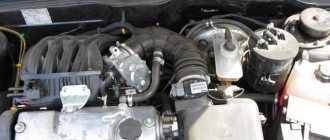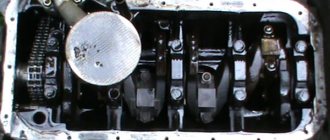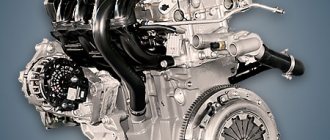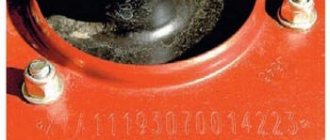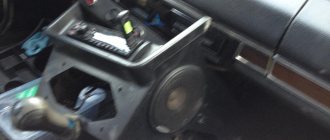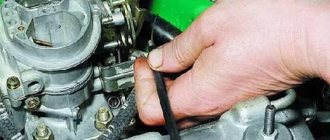Engine 21116 is a modified version of engine 21114 modification, with a displacement of 1.6 liters and a power of 87 horsepower.
This power unit has proven itself in operation as a fairly reliable option that combines throttle response and excellent efficiency indicators. The motor is easy to maintain and allows the car owner to carry out the necessary repair work independently.
Specifications
Motor specifications:
Download .xls file
xls
Download picture
Send by email
| PARAMETER | MEANING |
| Years of manufacture | 2011 – present |
| Motor weight, | 112 kg |
| Cylinder block material | cast iron |
| Supply system | injector |
| Type | in-line |
| Engine displacement | 1.6 |
| Power | 87 horsepower at 5100 rpm |
| Number of cylinders | 4 |
| Number of valves | 2 |
| Piston stroke | 75.6 |
| Cylinder diameter | 82 |
| Compression ratio | 10.5 |
| Torque, Nm/rpm | 140Nm / 3800 |
| Environmental standards | EURO 4 |
| Fuel | AI 95 |
| Fuel consumption | 7.2 l/100 km combined cycle |
| Oil | 5W-30 – 15W40 |
| Oil volume | 3.5 liters |
| When replacing, pour | 3.2 liters |
| The oil change is carried out | 15 thousand km |
| Engine life - according to factory data - in practice | 200 200+ |
The VAZ 21116 engine is installed on Lada: Granta, Kalina 2, Priora.
Engine 11186 - a domestic favorite
Engine 11186 is the minimum power unit in terms of power. which is standard equipment on Lada Granta and Lada Kalina cars. The VAZ 11186 engine is standardly coupled with a manual transmission. The start of serial production of the engine is in 2011. Environmental standards Euro-4.
The engine is structurally designed as an in-line gasoline four with a volume of 1586 cubic centimeters. Maximum power of 87 hp. reaches at 5100 rpm. Maximum torque of 140 Nm is produced at 3800 rpm.
It is the second iteration of the modification of the classic front-wheel drive engine 21083. The predecessor is the VAZ 21114 engine with a volume of 1.6 liters. The engine has an additional index VAZ 21116. The main difference is the use of a piston system on 11186, manufactured by AvtoVAZ OJSC, and not by Federal Mogul.
The declared engine life is 200,000 km. The actual mileage before the first major overhaul is not recorded. The Russian manufacturer does not have the practice of monitoring typed cars by mileage. According to existing unverified reviews, the actual mileage exceeds the service life of 21,114, but does not reach the declared one.
SOHC engine design diagram. One camshaft located at the top of the engine. Accordingly, we have 8 valves, 2 for each cylinder.
The camshaft is driven by a belt. During operation, the belt does not require replacement, since the declared life of the belt coincides with the life of the engine.
The belt tension is automatic and is designed by design.
Fuel supply system is injection with electronic control. Spark plugs are standard A17DVRM. The spark is supplied by the ignition unit according to the 2-2 scheme, i.e. spark is supplied to two cylinders at the same time
Modifications applied to the engine
To ensure normal temperature conditions of 95C when using gasoline with an octane rating of at least 95, the cooling system has been modified. Changed to increase the area and flow area of the cooling channels, and increased the volume of antifreeze poured.
Changes were made to the internal channels of the engine head. To ensure increased second consumption of antifreeze, a pump from a 16-valve engine is installed on the engine. In addition, the design of the thermostat has been changed.
In order to reduce fuel consumption and increase engine reliability, major modifications have been made. The engine is equipped with a connecting rod and piston group that is lightened by almost 40% compared to the VAZ-21114 engine.
This change not only reduced the weight of the engine itself, but, more importantly, reduced the inertia of the entire system. The design innovation made it possible to increase the declared service life before major repairs.
Externally, the motor also differs from its predecessor. A longer intake tract was installed, which made it possible to achieve a higher torque value and bring the performance of the 8-valve engine closer to the 16-valve engine.
The exhaust manifold has elongated pipes and a more voluminous resonator, which significantly facilitates the engine's breathing at the exhaust, since the aerodynamic resistance of the exhaust tract is reduced.
The generator mounting bracket has been changed to make it possible to adjust the drive belt using an eccentric tensioner roller. This design is also used on VAZ Vesta car engines.
Fuel used
The engine is designed to use fuel with an octane rating of at least 95. The use of 92 gasoline, according to the manufacturer, is not acceptable.
Oil used
According to the passport data and instructions for the technical operation of the power plant, synthetic and semi-synthetic oils are used. The use of mineral motor oils is not intended. The viscosity of the oil is selected based on the climatic characteristics of the region of operation.
Rosneft Maximum motor oil is used as a maintenance oil.
Maintenance frequency and cost
The regulated maintenance interval is 15,000 km or 1 year, whichever comes first. The calendar maintenance period is set based on the criteria for maintaining the lubricating properties of the engine oil, taking into account its possible oxidation. The air supply system filter element is changed every 30,000 km, as are the spark plugs.
The first valve adjustment is performed after running in the engine during TO-0, then at 15,000 km during TO-1 and then at 30,000 km intervals. At TO-5 (75,000 km), the oxygen sensor is changed, and the generator drive belt is changed at 90,000 km.
The average cost of maintenance, taking into account checking other vehicle systems without the cost of consumables, does not exceed 5,000 rubles.
Basic faults
Structurally, it is possible to bend the valves when the timing belt breaks. Using only the original belt avoids this problem. The problem can arise due to poor assembly, which is rare, or when the belt tension system fails. In the event of an emergency, the camshaft and even the crankshaft may be bent.
After performing repairs without replacing the main and connecting rod bearings, the pressure in the oil system may drop and oil consumption may increase. It is not possible to determine whether the valve bends when the belt actually breaks under operating conditions, since there is no open manufacturer data on such a malfunction.
Replacing the timing belt is not regulated by maintenance programs.
Troubleshooting, misfire. Failure of the ignition unit. The malfunction occurs due to a defect in the block itself. The unit cannot be repaired and must be replaced entirely.
Overheat. Associated with contamination of the surface of the cooling radiator. Another reason is a malfunction of the thermostat element, which may become stuck in the open or closed position. The most common problem is that the thermostat element is stuck in the open position, which results in a lower operating temperature of the engine.
Valve knocking. This is normal wear and tear. Eliminated by selecting adjusting washers.
The engine stalls at idle or while driving. There is a problem with the electronic sensors that the motor is equipped with. Basically, the problem is solved by replacing the mass fuel flow sensor (MAF)
Idle speed fluctuates. The reason is a problem with the idle speed sensor or due to the presence of air leaks into the vacuum brake booster (it is necessary to check the pipelines for damage).
High idle speed. This malfunction indicates a break in the crankcase gas suction pipeline.
Possibilities for engine modification and tuning
As an option to increase engine power, it is possible to carry out chip tuning in order to remove restrictions on the environmental class. The overall percentage of power increase will not exceed 2-5%.
Replacing the camshaft. It is not economically feasible, just like installing a turbocharger. Replacing the camshaft and receiver will remove 100 hp from the engine. If you additionally modify the cylinder head channels, you can gain an additional 20 hp.
To carry out such modifications, it is first necessary to change the engine design from SOHC to DOHC. That is, it is necessary to replace the cylinder head with a 16 valve with two camshafts. Such a replacement will increase the possible power of the 8-valve engine to 120 hp. without significant impact on the overall engine life.
In fact, modification of the engine comes down to converting it into a 16-valve version with the possibility of further refinement and increased power.
Source: https://AvtoDvigateli.com/marki/otechestvennyj-11186.html
Peculiarities
One of the features of this power unit is the light weight of the ShPG, which has a positive effect on the inertia of the power unit and the bolster masses.
The cylinder block is cast from durable cast iron and is characterized by increased resistance to overheating. The total weight of the power unit is 112 kilograms.
The use of an automatic engine control system 21116 made it possible to reduce fuel consumption. At the same time, the power increased and the noise from the running engine decreased. The updated 1.6 liter engine has received improved environmental performance, which allows it to be installed on new models of the Volzhsky Automobile Plant.
Among the shortcomings, we note a modified timing belt drive system, which breaks the valve if it breaks, which forces expensive engine repairs.
In previous generations of four-cylinder VAZ engines, a special timing drive design was used, which did not break the valves when broken. This is a significant drawback, since belt breaks on this engine are not uncommon, and such breakdowns require expensive engine repairs.
This fuel-injected engine has fully automatic control, is equipped with a gas distribution mechanism and has a power of 87 horsepower.
It must be said about the excellent fuel efficiency indicators. Lada Priora with a VAZ 21116 engine consumes 7.2 liters of gasoline in the combined cycle. Note that thanks to the use of an injector and a fully automatic engine control system, engine operation has become smooth at all speed levels.
Malfunctions
| FAULTS | CAUSES AND REMEDIES |
| Rough engine operation at idle. | This can be caused by problems with compression, so you need to check it in each cylinder and, if necessary, replace burnt valves. |
| The coolant temperature rises above 110 degrees. | The thermostat or pump responsible for antifreeze has failed. Repair consists of replacing damaged elements. |
| Uneven engine operation and loss of power. | The cause may be a faulty spark plug. It is necessary to check the presence of a spark and the condition of the high-voltage wires. |
| Loud bang, smoke from under the hood and engine failure. | Similar problems are typical for a broken timing belt. In this case, expensive major repairs are required. |
Faults and repairs of internal combustion engines 21116
Experienced mechanics often refer to the following faults:
- floating speed of the VAZ engine. In this case, the electronic throttle valve E-gas suffers. It is usually replaced with a new one;
- knocking noises in a VAZ engine appear when the valves do not operate synchronously. This happens when the VAZ engine valves are rarely adjusted. If the car owner has recently adjusted the valves, and knocking still continues to come from the engine, then experienced mechanics recommend checking the main or connecting rod bearings;
- engine tripping occurs due to the fact that the four-terminal ignition coil has failed. Sometimes the engine may stall due to burnt valves. True, recent breakdowns do not happen often;
- overheating occurs due to clogged cooling system pipes. Carbon deposits accumulate inside the pipes and radiator and prevent the oil from circulating normally. Breakdowns also occur with the thermostat, and the fan fails. Because of this, the motor overheats.
Similar article M273 Mercedes engine: main problems and reviews on the engine
If the water pump breaks, it is usually the timing belt that is stuck. In this case, the engine valves bend. Therefore, it is important to monitor the operation of the pump. Its timely replacement will save the VAZ car owner from major engine repairs.
During annual preventive maintenance, the following components are replaced:
- spark plugs are changed after 2 years or twenty thousand kilometers;
- oxygen sensor - after one hundred thousand kilometers;
- air and fuel filters are changed simultaneously after 40 thousand km;
- The battery is changed after two years if it has exhausted its lifespan.
After 40 thousand kilometers, they check the gas tank cap, fuel wire, fittings and hoses for cooling and heating the engine, and exhaust manifold.
Experienced car owners and mechanics can increase the power of a VAZ engine to 50 horses. But this will have a bad effect on the resource of the engine. Motor components will be subject to rapid wear. Therefore, for those who want to tune the engine to increase the power of the VAZ, it is recommended to consult with experienced mechanics. Perhaps they will advise modifying the exhaust manifold or replacing the standard pump with a pump from Luzar.
They can install a turbine. In this case, the cost of tuning will increase several times.
Tuning
Among the available tuning options we can note the following:
- Installation of a sports exhaust system.
- Chip tuning.
- Installation of turbocharging.
The most popular is the installation of turbocharging, which allows you to obtain engine power of 120 horsepower. A compressor with a pressure of 0.5 bar must be used. Simultaneously with the installation of supercharging, the piston group, crankshaft and fuel pump are replaced. This work is complex and only an experienced craftsman can carry it out correctly.
Chip tuning, although it is easy to operate, has not received the popularity it deserves. In total, after such a reconfiguration of the engine using a chip, it is possible to obtain no more than five additional horsepower. An increase in such power is practically not felt and does not give any increase in the dynamics of the car.
